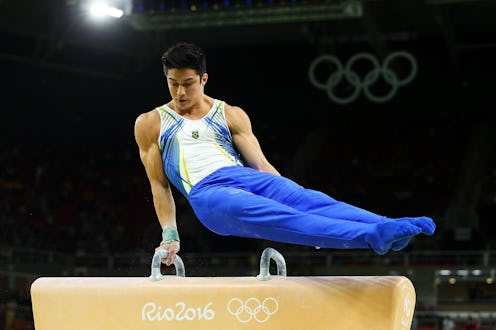News
The Pommel Horse Has A Fascinating History
As well as a time to view some of the most exciting athletic feats in the entire world, the Olympics are also a learning experience. I've gained knowledge of all sorts of sports-related things while watching the 2016 Rio Olympics, from why gymnasts wear socks to whether or not there has ever been a three-way tie in a swimming event. But one question that I still had, several days into the Games, was what the pommel horse actually is. Even though I was vaguely familiar with it, I definitely didn't consider myself an expert, and it turns out that there was a lot to learn about this gymnastics-related apparatus.
I'd seen the rectangular bricks with handles coming out on the top and knew they were used in gymnastics, but for awhile, I couldn't really explain much more than that (other than that gymnast dudes wearing leotards happened to look fine when doing their thang on the horse). So I went to Research Town to learn a little bit more about this gymnastic apparatus and the event that goes along with it, and it turns out that the history of the pommel horse is fascinating.
According to gymmedia.com, the pommel horse, a metal body covered with foam, rubber and leather, with plastic handles, is a device only used in men's gymnastics. The website reports that centuries ago, soldiers used the horses for training and had done so since the time of Alexander the Great (around 315 BCE), and in fact, that leader and the Macedonians used them to practice mounting and dismounting their actual horses. Later, knights and fencing schools used the horse for the same sort of practice, up until the late 18th century.
Since the 19th century, starting in Switzerland, the pommel horse has been used for the fascinating and intense men's artistic gymnastic event. According to About Sports, gymnasts are not allowed to stop during a routine, and they instead must keep moving once they've begun their routine on the horse or else face penalty. Routines are built on different types of circles (i.e. keeping one's body horizontal to the ground while swinging both legs together for one full rotation around the horse) and scissor work (i.e. switching the legs over the pommel horse all while swinging, which sometime entails going up to a handstand and back down). Routines also often include "flairs," a circle with legs straddled.
The pommel horse is very different from the other men's gymnastics events as it requires the athlete to spend much of his time on one hand, shifting his weight back and forth while moving from skill to skill. So while it's not as risky as other events (the rings actually make me feel nauseous with fear for the competitors), it definitely requires some serious balance and composure.
All gymnastic events are pretty mind-boggling to watch — how do they make their bodies do that?! — but the pommel horse takes the cake. The physicality that goes into the event is truly astounding, and those who master the event clearly are major champions. Good luck to Alexander Naddour, the Team USA contender in the final round of this intense (and like, kinda terrifying) event.
Images: USA Gymnastics/Youtube
